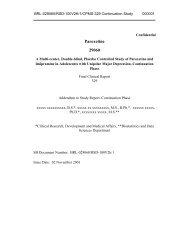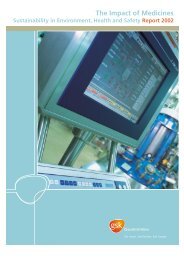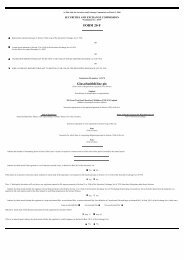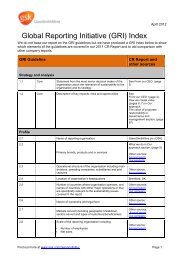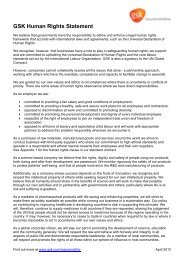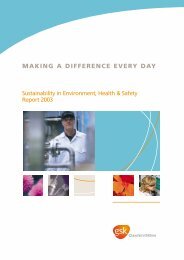GSK Annual Report 2002
GSK Annual Report 2002
GSK Annual Report 2002
You also want an ePaper? Increase the reach of your titles
YUMPU automatically turns print PDFs into web optimized ePapers that Google loves.
84 GlaxoSmithKline Notes to the financial statements<br />
2 Accounting policies continued<br />
Pensions and post-retirement benefits<br />
The cost of providing pensions and other employee post-retirement<br />
benefits is charged to the consolidated profit and loss account on a<br />
systematic and rational basis, based on actuarial assumptions, over<br />
the period during which benefit is derived from employees’ services.<br />
Any difference between this charge and the contributions paid is<br />
included as an asset or liability in the consolidated balance sheet.<br />
Employee share plans<br />
Incentives in the form of shares are provided to employees under<br />
share option and share award schemes. In respect of award<br />
schemes and certain share option grants, the company provides<br />
finance to ESOTs to purchase company shares on the open market<br />
to meet the company’s obligation to provide shares when<br />
employees exercise their option or award; any excess of the<br />
purchase price of the shares above the exercise price of the options<br />
and awards is charged to the profit and loss account over the<br />
periods of service in respect of which the options and awards are<br />
granted. In respect of other share option grants, share options<br />
when exercised are accounted for as share issues at exercise price.<br />
Additional employer costs in respect of options and awards are<br />
charged to the profit and loss account over the periods of service.<br />
Costs of running the ESOTs are charged to the profit and loss<br />
account. Shares held by the ESOTs are accounted for as fixed asset<br />
investments held at cost less a provision to recognise any shortfall<br />
in the proceeds receivable from employees on exercise unless there<br />
is deemed to be a permanent impairment in value.<br />
Goodwill<br />
Goodwill is stated at cost less a provision for amortisation.<br />
Amortisation is calculated to write off the cost in equal annual<br />
instalments over its expected useful life. The useful life is not<br />
normally expected to exceed 20 years.<br />
Intangible fixed assets<br />
Intangible assets are stated at cost less a provision for amortisation.<br />
Acquired licences, patents, know-how and marketing rights are<br />
amortised over their estimated useful lives in equal instalments,<br />
but no longer than 15 years. Items capitalised are restricted to<br />
those related to specific compounds or products which are being<br />
developed for commercial applications. The estimated useful lives<br />
for determining the amortisation charge are reviewed annually,<br />
and take into account the estimated time it takes to bring the<br />
compounds or products to market as marketable products.<br />
Any development costs which are incurred by the Group and<br />
are associated with an acquired licence, patent, know-how<br />
or marketing rights are written off to the profit and loss account<br />
when incurred.<br />
Brands are valued independently as part of the fair value of<br />
businesses acquired from third parties where the brand has a value<br />
which is substantial and long-term and where the brands can be<br />
sold separately from the rest of the businesses acquired. Brands<br />
are amortised over the estimated useful lives but no longer than<br />
20 years, except where the end of the useful economic life of the<br />
brand cannot be foreseen.<br />
Prior to 1998, acquired minor brands and similar intangibles were<br />
eliminated in the Group balance sheet against reserves in the year<br />
of acquisition.<br />
Tangible fixed assets<br />
Tangible fixed assets are stated at cost less provisions for<br />
depreciation or impairment. The costs of acquiring and developing<br />
computer software for internal use and internet sites for external<br />
use are capitalised as a tangible fixed asset where the software or<br />
site supports a significant business system and the expenditure<br />
leads to the creation of a durable asset.<br />
Depreciation is calculated to write off the cost of tangible fixed<br />
assets, excluding freehold land, in equal annual instalments over<br />
their expected useful lives. The normal expected useful lives of the<br />
major categories of tangible fixed assets are reviewed annually<br />
and are:<br />
Freehold buildings 20 to 50 years<br />
Leasehold land and The shorter of lease term and 50<br />
buildings years<br />
Plant and machinery 10 to 20 years<br />
Fixtures and equipment 3 to 10 years<br />
ERP systems software 7 years<br />
Other computer software 3 to 5 years<br />
ERP systems software generally involves significant customisation<br />
prior to implementation and is expected to have a useful economic<br />
life of seven years, rather than the maximum five years of other<br />
computer software.<br />
On disposal of a tangible fixed asset, the cost and related<br />
accumulated depreciation are removed from the financial<br />
statements and the net amount, less any proceeds, is taken to<br />
the consolidated profit and loss account.<br />
Leases<br />
Leasing agreements which transfer to the Group substantially all<br />
the benefits and risks of ownership of an asset are treated as<br />
finance leases, as if the asset had been purchased outright. The<br />
assets are included in tangible fixed assets and the capital element<br />
of the leasing commitments is shown as obligations under finance<br />
leases. Assets held under finance leases are depreciated over the<br />
shorter of the lease terms and the useful lives of the assets. The<br />
interest element of the lease rental is charged against profit.<br />
All other leases are operating leases and the annual rentals are<br />
charged against profit on a straight-line basis over the lease term.<br />
Impairment of fixed assets<br />
The carrying values of fixed assets are reviewed for impairment<br />
when there is an indication that the assets might be impaired.<br />
Any provision for impairment is charged against profit in the year<br />
concerned. First year impairment reviews are conducted for<br />
acquired goodwill and intangible assets. Certain intangibles are<br />
considered to have an indefinite life and are therefore not<br />
amortised. Such intangibles are subject to annual impairment tests.<br />
Impairment is determined by reference to the higher of net<br />
realisable value and value in use, which is measured by reference<br />
to discounted future cash flows. The value of shares held by the<br />
ESOTs is reviewed quarterly to determine if there is any permanent<br />
impairment.<br />
Investments in joint ventures and associates<br />
Investments in joint ventures and associated undertakings are<br />
carried in the consolidated balance sheet at the Group’s share<br />
of their net assets at date of acquisition and of their postacquisition<br />
retained profits or losses together with any goodwill<br />
arising on the acquisition, net of amortisation.








